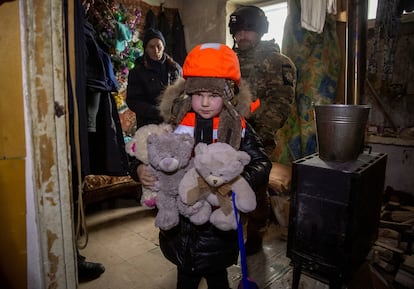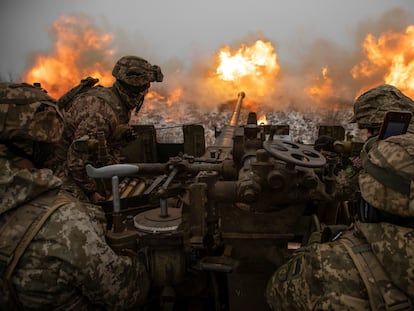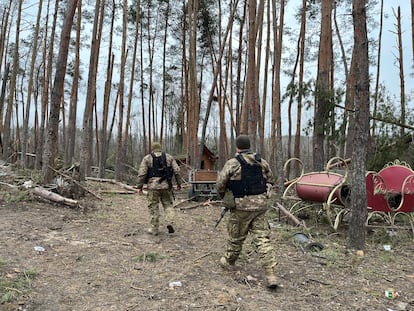Battle for Bakhmut turns into a ‘meat grinder’ for Russian and Ukrainian armies
Estimates of casualties on both sides during fierce fighting for the city have increased hugely since January as Kyiv’s allies urge abandoning its defense for a fresh counter-offensive in the south

The battle for control of Bakhmut, one of the bloodiest of the Ukraine war to date, is a “meat grinder,” in the words of Yevgeny Prigozhin, the businessman who heads up the mercenary Wagner Group, which has been described as the personal army of Russian President Vladimir Putin. The offensive to capture this key city on the Donetsk front has resulted in the deaths of thousands of Wagner troops, but the Ukrainian defenders have also suffered heavily. Neither side reports its casualties but the intelligence services of various NATO countries have warned that the price Kyiv is paying to keep its flag flying over Bakhmut is too high.
On January 20, German daily Der Spiegel revealed that the German BND secret service had told a Bundestag security commission that the Armed Forces of Ukraine were suffering daily casualties – killed, wounded or missing in action – numbering “three figures.” The last official report on Ukrainian losses was provided by Mykhailo Podolyak, adviser to Volodymyr Zelenskiy, who said that the Ukrainian military was reporting between 100 and 200 casualties a day across all fronts.
The New York Times published a report at the end of November stating that Bakhmut hospital was attending to 240 wounded Ukrainian soldiers per day. Since then, the situation for the city’s defenders has worsened. Russia has been targeting Bakhmut since the beginning of the invasion, but it was last November that the Kremlin launched its full military might against the city. Attacks have intensified since January 6, when a surprise attack by Wagner mercenaries gave them almost total control of Soledar, a town located 11 miles from Bakhmut. Now, the Russian mercenaries are besieging the city on three flanks, with the opposing armies locked in street-to-street combat.
Wagner mercenaries being used as cannon fodder
According to the BND, Russian losses are far higher than Ukrainian casualties because the Wanger mercenaries do not employ military tactics, with commanders sending their men in as cannon fodder. Independent Russian media outlet Meduza published a chilling statistic on January 23 from an investigation by the NGO Rus Sidyashchaya, which specializes in the rights of prisoners: of the 50,000 Russian inmates who volunteered to join the ranks of the Wagner Group, only 10,000 are still fighting. The remainder have been killed, wounded or are missing in action – or have deserted.
At the end of December, Podolyak said that the number of Ukrainian soldiers killed in the war could be around 13,000. A traditional calculation in military theory is that combat deaths account for roughly a third of all casualties. That suggests, based on Podolyak’s estimation, that Kyiv had suffered 40,000 losses – killed wounded, missing or captured – overall. But recent academic studies published by institutions such as MIT and the Harvard Kennedy School state that the ratio of combat deaths has improved over the past few decades to one for every 10 wounded, due to advances in battlefield medical technology. Taking Podolyak’s figures into account, estimates of Ukrainian losses rise to as many as 100,000. That number aligns with US military estimates. In November, chairman of the Joint Chiefs of Staff Mike Milley said that losses on both sides stood at around 100,000. His Norwegian counterpart, Eirik Kristoffersen, said during an interview on January 22 that Ukrainian losses were around 100,000 soldiers, compared to 180,000 Russian troops.

Allied concerns over Bakhmut
While it remains reluctant to publish Ukrainian losses, Kyiv’s High Command does release daily estimates of the number of enemy casualties. On January 31, that number stood at 127,000 Russian servicemen killed in action, a figure that independent analysts question. An example of the disparity in casualty reports from both sides was provided on January 1, when Ukrainian missiles hit a temporary barracks housing a Russian battalion in Makiivka, on the Donetsk front. According to Kyiv, the strike left 400 Russian troops dead, while Moscow stated losses were fewer than 100. British intelligence concluded last week that the real figure was 300, while a BBC investigation placed the number at 100. The BBC’s Russia service, together with independent media outlet Mediazona, calculated last week that Russian casualties overall stood at 110,000, and that the number of soldiers killed in combat had increased considerably since Moscow started sending conscripts to the front lines last September.
Ukrainian estimates of Russian losses do however serve to give an idea of the scale of slaughter in Bakhmut. Between January 6 and 31, the Ukrainian High Command claims 17,000 Russian troops lost their lives in the battle, a figure that represents almost double the monthly average reported by Kyiv throughout 2022.
The struggle for Bakhmut has become more of a matter of honor than a strategic objective for both sides. Should Russia prevail, it will signify the first battlefield victory for the Kremlin since last July, after which humiliating retreats on the Kharkiv and Kherson fronts swung momentum toward Kyiv. For Zelenskiy, Bakhmut has become another symbol of Ukrainian resistance. During a surprise visit to the front in December, the Ukrainian president said the defense of Bakhmut was critical “for Donbas and Ukraine.”
But Kyiv’s Western allies have their doubts about the military value of continued carnage in Bakhmut. A recent CNN report cited senior US and NATO officials suggesting that Ukraine should abandon its defense of Bakhmut and concentrate on a fresh attack backed by NATO-supplied heavy armor in the south, preferably in Zaporizhzhia, to sever the connection between the Russian border, the occupied territories in the Sea of Azov and Kherson.
In a visit to Bakhmut on January 13, EL PAÍS confirmed that Ukrainian forces have already fortified new defensive lines around the city in case Russian forces break though and decide to launch an offensive further west. This newspaper gathered the testimony of at least two battalions – one infantry and one armored – who had been forced to withdraw from the front line due to a lack of ammunition and high numbers of casualties. The Ukrainian authorities have so far managed, for propaganda reasons, to keep images of wounded fighters away from the public eye, but as the battle for Bakhmut has worn on more and more soldiers are sharing graphic accounts of the reality on the front lines of the besieged city.
Sign up for our weekly newsletter to get more English-language news coverage from EL PAÍS USA Edition
Tu suscripción se está usando en otro dispositivo
¿Quieres añadir otro usuario a tu suscripción?
Si continúas leyendo en este dispositivo, no se podrá leer en el otro.
FlechaTu suscripción se está usando en otro dispositivo y solo puedes acceder a EL PAÍS desde un dispositivo a la vez.
Si quieres compartir tu cuenta, cambia tu suscripción a la modalidad Premium, así podrás añadir otro usuario. Cada uno accederá con su propia cuenta de email, lo que os permitirá personalizar vuestra experiencia en EL PAÍS.
¿Tienes una suscripción de empresa? Accede aquí para contratar más cuentas.
En el caso de no saber quién está usando tu cuenta, te recomendamos cambiar tu contraseña aquí.
Si decides continuar compartiendo tu cuenta, este mensaje se mostrará en tu dispositivo y en el de la otra persona que está usando tu cuenta de forma indefinida, afectando a tu experiencia de lectura. Puedes consultar aquí los términos y condiciones de la suscripción digital.
More information
Archived In
Últimas noticias
Most viewed
- David King, chemist: ‘There are scientists studying how to cool the planet; nobody should stop these experiments from happening’
- Reinhard Genzel, Nobel laureate in physics: ‘One-minute videos will never give you the truth’
- Mexico completes its trade shift with the entry into force of tariffs on China and countries without trade agreements
- Oona Chaplin: ‘I told James Cameron that I was living in a treehouse and starting a permaculture project with a friend’
- Sinaloa Cartel war is taking its toll on Los Chapitos











































